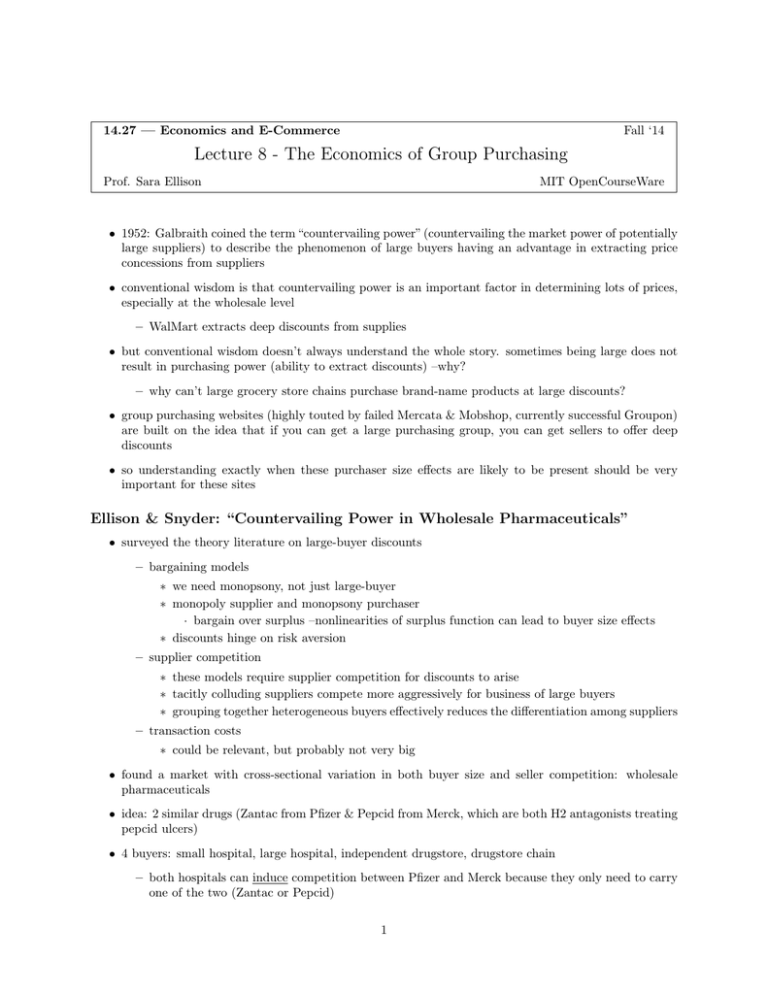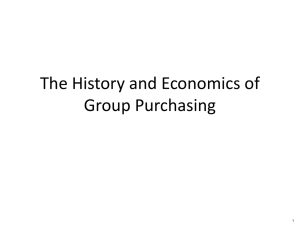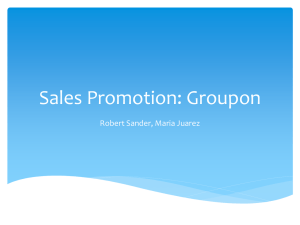Lecture 8 - The Economics of Group Purchasing
advertisement

14.27 — Economics and E-Commerce Fall ‘14 Lecture 8 - The Economics of Group Purchasing Prof. Sara Ellison MIT OpenCourseWare • 1952: Galbraith coined the term “countervailing power” (countervailing the market power of potentially large suppliers) to describe the phenomenon of large buyers having an advantage in extracting price concessions from suppliers • conventional wisdom is that countervailing power is an important factor in determining lots of prices, especially at the wholesale level – WalMart extracts deep discounts from supplies • but conventional wisdom doesn’t always understand the whole story. sometimes being large does not result in purchasing power (ability to extract discounts) –why? – why can’t large grocery store chains purchase brand-name products at large discounts? • group purchasing websites (highly touted by failed Mercata & Mobshop, currently successful Groupon) are built on the idea that if you can get a large purchasing group, you can get sellers to offer deep discounts • so understanding exactly when these purchaser size effects are likely to be present should be very important for these sites Ellison & Snyder: “Countervailing Power in Wholesale Pharmaceuticals” • surveyed the theory literature on large-buyer discounts – bargaining models ∗ we need monopsony, not just large-buyer ∗ monopoly supplier and monopsony purchaser · bargain over surplus –nonlinearities of surplus function can lead to buyer size effects ∗ discounts hinge on risk aversion – supplier competition ∗ these models require supplier competition for discounts to arise ∗ tacitly colluding suppliers compete more aggressively for business of large buyers ∗ grouping together heterogeneous buyers effectively reduces the differentiation among suppliers – transaction costs ∗ could be relevant, but probably not very big • found a market with cross-sectional variation in both buyer size and seller competition: wholesale pharmaceuticals • idea: 2 similar drugs (Zantac from Pfizer & Pepcid from Merck, which are both H2 antagonists treating pepcid ulcers) • 4 buyers: small hospital, large hospital, independent drugstore, drugstore chain – both hospitals can induce competition between Pfizer and Merck because they only need to carry one of the two (Zantac or Pepcid) 1 Lecture 8 The Economics of Group Purchasing 14.27, Fall ‘14 – neither drugstore can induce competition between Pfizer and Merck because they need to carry both drugs. why? customers walk in with a specific drug that neither they nor the pharmacist has the power to change, and so they will lose customers who have prescriptions for drugs they don’t carry. • look at prices paid for these drugs at various places: small size large size able to induce competition ? low unable to induce competition high tiny bit lower • so, unless buyers could induce competition, size bought them nothing • connection to group purchasing websites: – website might have means to corral large purchasing group, but unless it uses that group to induce competition between suppliers, large discounts are unlikely to result Mobshop & Mercata (circa 2000) • listed a particular model, e.g. a Sony DVD player for $100 if up to 5 people agree to buy, $100 if 6 to 25 people agree to buy, $95 if 25-100 people agree to buy, $90 • buyers must commit to buy at current price, but may get lower price • no way to communicate cross-price elasticities (i.e., if this similar Samsung model were a good deal, I’d be happy to switch) • then Mercata goes to Sony and says “I have 157 people who have already agreed to buy this particular DVD player” instead of “I have 157 who want the best deal they can get on a DVD with these features and yours, Samsung’s, and Toshiba’s all fit the bill –what can you do for me?” Groupon • somewhat different model: – whereas Mobshop & Mercata offered a lot of one-time purchase items or durables (e.g. electronics), Groupon offers goods & services likely to be repeat purchases, which suggests advertising function might be more important – originally, the deal was not available unless enough people sign up (this is not true anymore) – buyers pay up front and have, say, six months to use ( 15 never do) – sellers get free advertising campaign – sellers receive contact info for all purchasers (for future marketing) • makes offering discounts more attractive to sellers, so discounts are likely to be large regardless of group purchasing nature • still, are they effectively using group purchasing power by doing things to induce competition? • or are they giving away valuable information services to sellers to get them to sign up and masking this with claims about power of group purchasing? 2 Lecture 8 The Economics of Group Purchasing 14.27, Fall ‘14 • not entirely clear • another issue: does Groupon attract a disproportionate share of “cheapskates” who will not make repeat or additional purchases and will be worse customers? – the group of customers that come through Groupon is not just bigger but could be different – we will revisit this issue of adverse selection of customers later in the semester • “Daily Deals: Prediction, Social Diffusion, and Repetitional Ramifications” by Byers, Mitzenmacher, and Zervas – running average Yelp rating (reset on data of Groupon deal) of 5000 merchants who ran Groupon deals – running average not reset at 180 (so no discontinuity) but dip –large fraction of deals expire at 6 months, so spike in Groupon users right before that, which suggests that Yelp ratings suffer after Groupon users use the service, not after it’s just advertised. ∗ Yelp ratings just decline over time (this is statistically significant breakpoint & decline) ∗ unprepared businesses (or ones that discriminate against Groupon users) ∗ Groupon users are different: · more critical (this is not true, they’re actually less likely to give 1s and 5s) · less likely to like service because they needed a strong financial inducement to try it ∗ actual reviews from flood of new customers crowd out fake reviews 3 MIT OpenCourseWare http://ocw.mit.edu 14.27 Economics and E-Commerce Fall 2014 For information about citing these materials or our Terms of Use, visit: http://ocw.mit.edu/terms.





